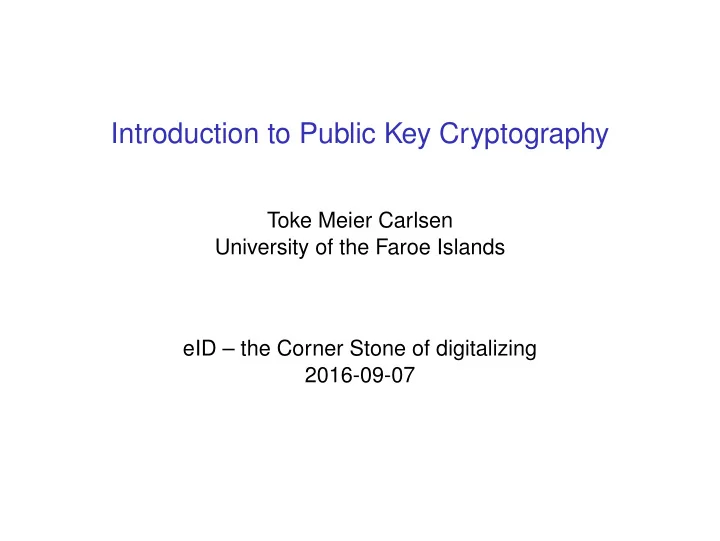

Introduction to Public Key Cryptography Toke Meier Carlsen University of the Faroe Islands eID – the Corner Stone of digitalizing 2016-09-07
What is cryptography?
What is cryptography? Hello Alice Hello Alice Bobs wants to send messages to Alice.
What is cryptography? Hello Alice Hello Alice Bobs wants to send messages to Alice. But he is afraid Donald will intercept the messages.
What is cryptography? Hello Alice Hello Alice Bobs wants to send messages to Alice. But he is afraid Donald will intercept the messages. Bob and Alice therefore agree on some way (that Donald doesn’t know about) of converting messages into codes (this is called encryption ) and how to reconstruct a message from its code (this is called decryption ).
What is cryptography? encryption decryption Hello Alice 001011 001011 Hello Alice Bobs wants to send messages to Alice. But he is afraid Donald will intercept the messages. Bob and Alice therefore agree on some way (that Donald doesn’t know about) of converting messages into codes (this is called encryption ) and how to reconstruct a message from its code (this is called decryption ). When Bob wants to send a message to Alice, he can then encrypt it into a code, and then send the code to Alice who can then decrypt the code and recover the message.
What is cryptography? encryption decryption Hello Alice 001011 001011 Hello Alice Bobs wants to send messages to Alice. But he is afraid Donald will intercept the messages. Bob and Alice therefore agree on some way (that Donald doesn’t know about) of converting messages into codes (this is called encryption ) and how to reconstruct a message from its code (this is called decryption ). When Bob wants to send a message to Alice, he can then encrypt it into a code, and then send the code to Alice who can then decrypt the code and recover the message. Even if Donald intercept the code that Bob sends to Alice, he will not be able to recover the original message because he doesn’t know how to decrypt it.
Symmetric-key and public-key cryptography There are two types of cryptography: symmetric-key cryptography and public-key cryptography .
Symmetric-key and public-key cryptography There are two types of cryptography: symmetric-key cryptography and public-key cryptography . With symmetric-key cryptography, Bob and Alice agree on a way of encrypting and decrypting that the both know (this is called a symmetric key ).
Symmetric-key and public-key cryptography There are two types of cryptography: symmetric-key cryptography and public-key cryptography . With symmetric-key cryptography, Bob and Alice agree on a way of encrypting and decrypting that the both know (this is called a symmetric key ). With public-key cryptography, only Alice knows how to decrypt a message (using her private key ), and Bob (and others) only knows how to encrypt a message (using Alice’s public key ).
Symmetric-key and public-key cryptography There are two types of cryptography: symmetric-key cryptography and public-key cryptography . With symmetric-key cryptography, Bob and Alice agree on a way of encrypting and decrypting that the both know (this is called a symmetric key ). With public-key cryptography, only Alice knows how to decrypt a message (using her private key ), and Bob (and others) only knows how to encrypt a message (using Alice’s public key ). An advantage of symmetric-key cryptography is that it is simpler and therefore faster than public-key cryptography.
Symmetric-key and public-key cryptography There are two types of cryptography: symmetric-key cryptography and public-key cryptography . With symmetric-key cryptography, Bob and Alice agree on a way of encrypting and decrypting that the both know (this is called a symmetric key ). With public-key cryptography, only Alice knows how to decrypt a message (using her private key ), and Bob (and others) only knows how to encrypt a message (using Alice’s public key ). An advantage of symmetric-key cryptography is that it is simpler and therefore faster than public-key cryptography. The advantages of public-key cryptography is that it is more secure than symmetric-key cryptography, and that it does not require a secure channel for the initial exchange of secret keys between Bob and Alice.
Usage of public-key cryptography Public-key cryptography is often used to securely transfer keys used for symmetric-key cryptography ( session keys ).
Usage of public-key cryptography Public-key cryptography is often used to securely transfer keys used for symmetric-key cryptography ( session keys ). Public-key cryptography can also be used to authenticate the identity of the sender of a message (this is called digital signature ).
Usage of public-key cryptography Public-key cryptography is often used to securely transfer keys used for symmetric-key cryptography ( session keys ). Public-key cryptography can also be used to authenticate the identity of the sender of a message (this is called digital signature ). If for example Alice wants to send a message to Bob such that Bob knows for certain that the message is from her, Alice encrypts the message with her own private key and then send the code to Bob.
Usage of public-key cryptography Public-key cryptography is often used to securely transfer keys used for symmetric-key cryptography ( session keys ). Public-key cryptography can also be used to authenticate the identity of the sender of a message (this is called digital signature ). If for example Alice wants to send a message to Bob such that Bob knows for certain that the message is from her, Alice encrypts the message with her own private key and then send the code to Bob. Bob can then decrypt the message with Alice’s public key. Bob knows that the message came from Alice, because otherwise he would not be able to decrypt it with Alice’s public key.
Recommend
More recommend